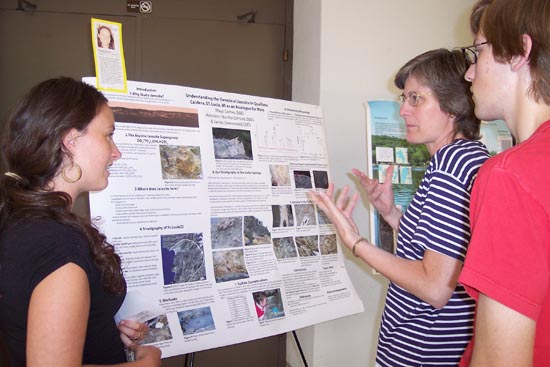49 Fellows Present Research during Hughes Poster Session
 |
| At left, Hughes Associate, Mellon Fellow and Earth and Environmental Sciences Major Maya Gomes ’06 discusses her research with interested onlookers during the 17th annual Hughes Summer Research Program Poster Session Aug. 5. Gomes’ poster was titled “Understanding the Genesis of Jarosite in Qualibou Caldera, Saint Lucia as an Analogue for Mars.” |
| Posted 08/17/05 |
| Chimpanzee studies, eating behaviors, mice brains and even sperm banks were topics of research presented at the 17th annual Hughes Summer Research Program Poster Session Aug. 5 at the Exley Science Center.
After 10 weeks of intense research, 49 Hughes Fellows presented their projects. Hughes Fellows are supported by the Hughes Program in the Life Sciences, funded by the Howard Hughes Medical Institute. The fellows worked one-on-one with Wesleyan faculty advisors. Students presented a wide array of projects. Matthew Donne 07 presented his work on Hedgehog Signaling and Blood Vessel Development. Owen Kiely 06 presented research on Uncovering the Timetable for Functional Incorporation of New Neurons in the Adult Brain. And Alexandra Ogrodnik 06 presented her research titled Gypsy Moths, Invaders vs. Local Caterpillars. For the students presenting, the program gave them a variety of research opportunities that wouldve been difficult to replicate during the school year. What I liked about this most was that it gave me a lot of field experience that I otherwise would never have had, says Daniel Silva ’07. It really showed us how different the field could be from laboratory conditions. Silva and Ulyana Sorokopoud ’08, both Hughes Fellows, presented the poster ”Metapopulation Analyses of Freshwater Fishes and Macrovertebrates: Ecosystem Assessment of the Matabesset and Eight Mile River Water Sheds. Doing this work in the field was really eye-opening, says Sorokopoud. For example, we took multiple times samples over a month. During that period we could see a number of changes that took place in the habitat, some subtle, some not so subtle. But they were nothing we wouldve seen under lab conditions.” For Hughes Fellow Jenna Gopilan ’07, who presented The Effects of Serotonin on Adult Neurogenesis in the Dentale Gyrus of DNA Pkcs Mice, the experience was all about lab conditions, which was a good thing. I was able to devote entire days in the lab and perform more experiments, which helped me generate a lot more useful data, she says. I could have never fit that much work in with my class schedule during the semester. Getting a chance to devote full days and weeks to my work in the lab was perfect. The poster session was accompanied with laboratory tours and a colloquium. Martha Gilmore, assistant professor of earth and environmental sciences. Gilmore spoke on Mars: Wetter than Ever. Michael Weir, professor of biology and chair of the Biology Department is the director of the Hughes Program in the Life Sciences. Laurel Appel, visiting associate professor of biology and senior research associate is the program coordinator. Students applying for the 2006 Hughes Program must do so by March 3, 2006. The grant budget allows for 18 stipends, but with generous contributions from participating departments and faculty, as well as Financial Aid funds, the program can accept between 40 and 50 students each year. Students are responsible for their own housing. For more information contact Maureen Snow, administrative assistant for the Hughes Program in the Life Sciences, at msnow@wesleyan.edu. |
| By David Pesci, director of Media Relations |

